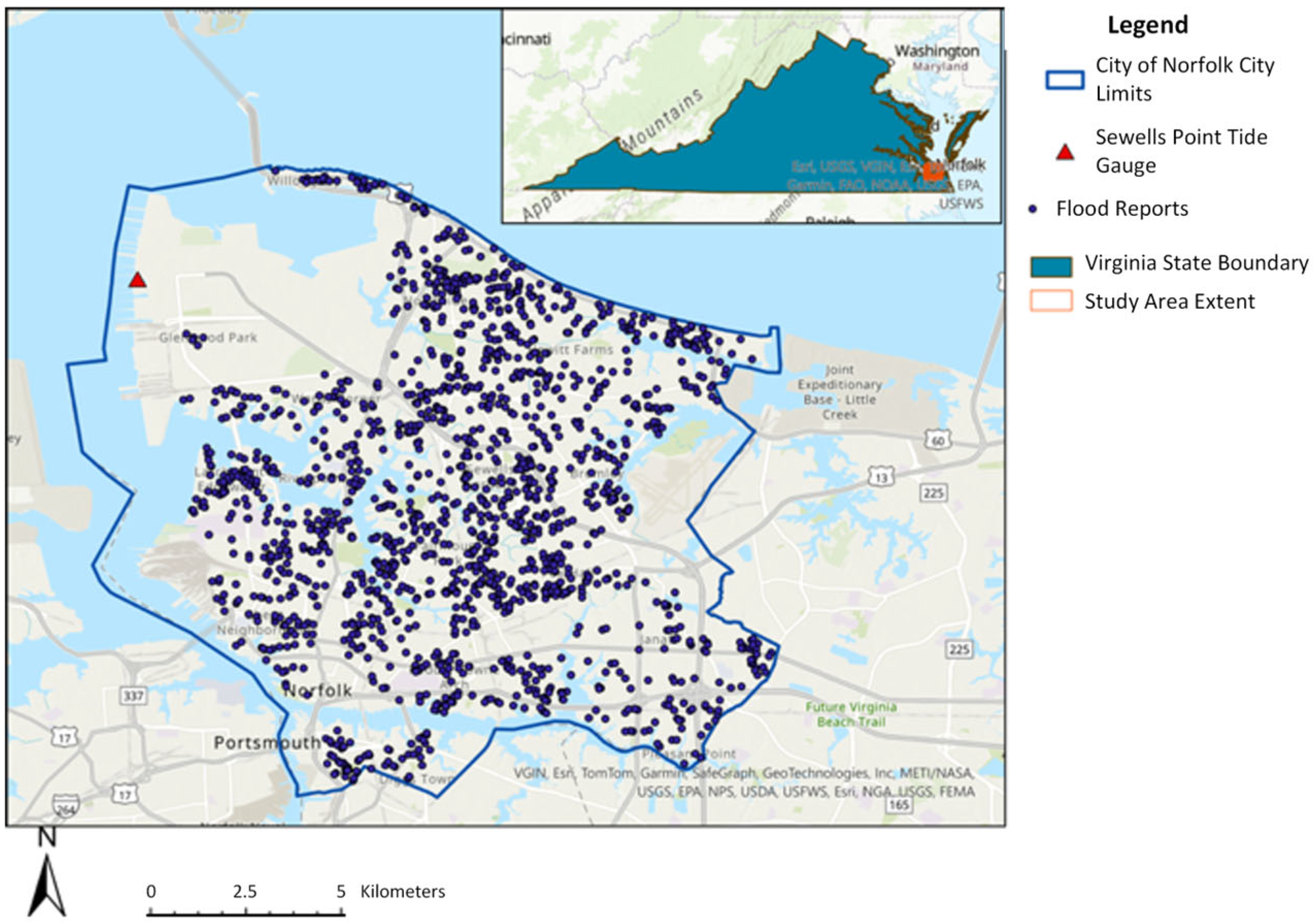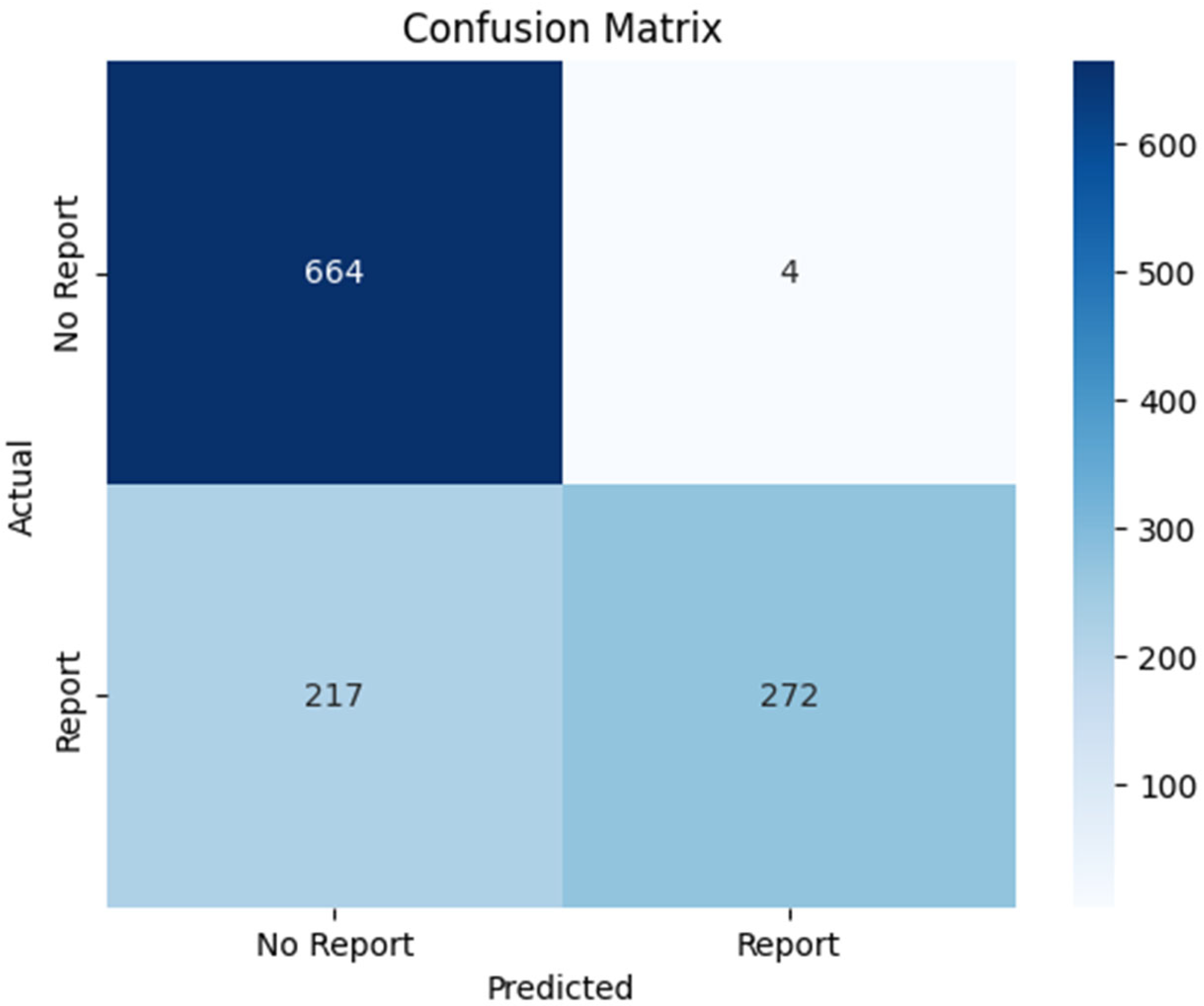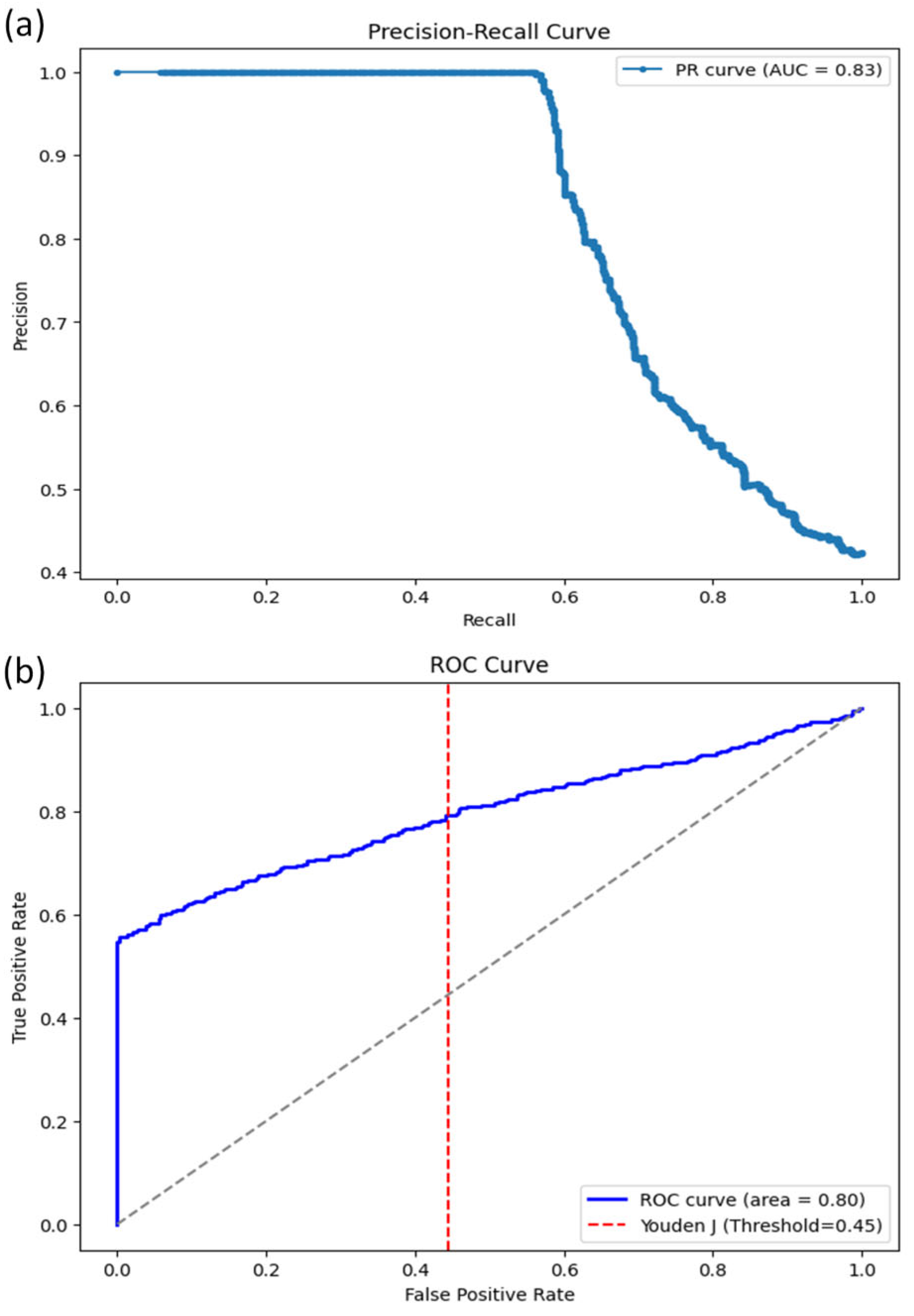Uncovering the Drivers of Urban Flood Reports: An Environmental and Socioeconomic Analysis Using 311 Data
Abstract
1. Introduction
- What are the most influential predictors in determining the likelihood of a flood report within the study area, as identified through permutation-based feature importance?
- To what extent do racial demographic variables demonstrate influence on the prediction of flood reports, as assessed by permutation-based feature importance?
- What is the direction of the relationship between specific racial demographic variables and the log-odds of a flood report, as indicated by the coefficients of the logistic regression model?
2. Materials and Methods
2.1. Study Area
2.2. Data and Preprocessing
2.3. Building the Logistic Regression Classification Model
3. Results
3.1. Logistic Regression Model Coefficients and Statistical Significance
3.2. Model Performance Metrics
3.3. Permutation-Based Feature Importance: Identifying Salient Predictors
4. Discussion
4.1. Environmental Predictors of Flood Reporting
4.2. Demographic Influences on Reporting Behavior
4.3. Education and Income Reporting Disparities
5. Conclusions
- The 24 h cumulative precipitation on the day the flood stoppage was reported.
- The maximum verified water level at Sewell’s Point tide station on the day the flood stoppage was reported.
- The TWI at the location where the flood stoppage was reported.
- The percentage of Black residents in the US Census Tract in which the flood stoppage was reported.
- The percentage of Hispanic residents in the US Census Tract in which the flood stoppage was reported.
- The percentage of Asian residents in the US Census Tract in which the flood stoppage was reported.
- The percentage of residents of two or more races in the US Census Tract in which the flood stoppage was reported.
- The Median household income for the US Census Tract in which the flood stoppage was reported.
- The proportion of residents within the study’s defined level of educational attainment categories in the US Census Tract in which the flood stoppage was reported.
Author Contributions
Funding
Data Availability Statement
Acknowledgments
Conflicts of Interest
Abbreviations
| TWI | Topographic Wetness Index |
| SLR | Sea Level Rise |
| RSLR | Relative Sea Level Rise |
| ROC | Receiver Operator Characteristic |
| AUC | Area Under the Curve |
References
- NOAA National Centers for Environmental Information (NCEI). U.S. Billion-Dollar Weather and Climate Disasters; NOAA National Centers for Environmental Information (NCEI): Asheville, NC, USA, 2025. [Google Scholar] [CrossRef]
- Lin, N.; Kopp, R.E.; Horton, B.P.; Donnelly, J.P. Hurricane Sandy’s Flood Frequency Increasing from Year 1800 to 2100. Proc. Natl. Acad. Sci. USA 2016, 113, 12071–12075. [Google Scholar] [CrossRef]
- Van Oldenborgh, G.J.; Van Der Wiel, K.; Sebastian, A.; Singh, R.; Arrighi, J.; Otto, F.; Haustein, K.; Li, S.; Vecchi, G.; Cullen, H. Attribution of Extreme Rainfall from Hurricane Harvey, August 2017. Environ. Res. Lett. 2017, 12, 124009. [Google Scholar] [CrossRef]
- Wahl, T.; Jain, S.; Bender, J.; Meyers, S.D.; Luther, M.E. Increasing Risk of Compound Flooding from Storm Surge and Rainfall for Major US Cities. Nat. Clim. Change 2015, 5, 1093–1097. [Google Scholar] [CrossRef]
- Shen, Y.; Morsy, M.M.; Huxley, C.; Tahvildari, N.; Goodall, J.L. Flood Risk Assessment and Increased Resilience for Coastal Urban Watersheds under the Combined Impact of Storm Tide and Heavy Rainfall. J. Hydrol. 2019, 579, 124159. [Google Scholar] [CrossRef]
- Moftakhari, H.R.; AghaKouchak, A.; Sanders, B.F.; Feldman, D.L.; Sweet, W.; Matthew, R.A.; Luke, A. Increased Nuisance Flooding along the Coasts of the United States Due to Sea Level Rise: Past and Future. Geophys. Res. Lett. 2015, 42, 9846–9852. [Google Scholar] [CrossRef]
- Suarez, P.; Anderson, W.; Mahal, V.; Lakshmanan, T.R. Impacts of Flooding and Climate Change on Urban Transportation: A Systemwide Performance Assessment of the Boston Metro Area. Transp. Res. Part D Transp. Environ. 2005, 10, 231–244. [Google Scholar] [CrossRef]
- Jacobs, J.M.; Cattaneo, L.R.; Sweet, W.; Mansfield, T. Recent and Future Outlooks for Nuisance Flooding Impacts on Roadways on the U.S. East Coast. Transp. Res. Rec. J. Transp. Res. Board 2018, 2672, 1–10. [Google Scholar] [CrossRef]
- Nabangchang, O.; Allaire, M.; Leangcharoen, P.; Jarungrattanapong, R.; Whittington, D. Economic Costs Incurred by Households in the 2011 Greater Bangkok Flood. Water Resour. Res. 2015, 51, 58–77. [Google Scholar] [CrossRef]
- Cherqui, F.; Belmeziti, A.; Granger, D.; Sourdril, A.; Le Gauffre, P. Assessing Urban Potential Flooding Risk and Identifying Effective Risk-Reduction Measures. Sci. Total Environ. 2015, 514, 418–425. [Google Scholar] [CrossRef]
- Moftakhari, H.R.; AghaKouchak, A.; Sanders, B.F.; Matthew, R.A. Cumulative Hazard: The Case of Nuisance Flooding. Earth’s Future 2017, 5, 214–223. [Google Scholar] [CrossRef]
- Bedient, P.B.; Huber, W.C.; Vieux, B.E. Hydrology and Floodplain Analysis, 4th ed.; Prentice Hall: Upper Saddle River, NJ, USA, 2008; ISBN 978-0-13-174589-6. [Google Scholar]
- Kalyanapu, A.J.; Shankar, S.; Pardyjak, E.R.; Judi, D.R.; Burian, S.J. Assessment of GPU Computational Enhancement to a 2D Flood Model. Environ. Model. Softw. 2011, 26, 1009–1016. [Google Scholar] [CrossRef]
- Bates, P.D.; Anderson, M.G.; Baird, L.; Walling, D.E.; Simm, D. Modelling Floodplain Flows Using a Two-dimensional Finite Element Model. Earth Surf. Process. Landf. 1992, 17, 575–588. [Google Scholar] [CrossRef]
- Knebl, M.R.; Yang, Z.L.; Hutchison, K.; Maidment, D.R. Regional Scale Flood Modeling Using NEXRAD Rainfall, GIS, and HEC-HMS/ RAS: A Case Study for the San Antonio River Basin Summer 2002 Storm Event. J. Environ. Manag. 2005, 75, 325–336. [Google Scholar] [CrossRef] [PubMed]
- Leandro, J.; Chen, A.S.; Djordjević, S.; Savić, D.A. Comparison of 1D/1D and 1D/2D Coupled (Sewer/Surface) Hydraulic Models for Urban Flood Simulation. J. Hydraul. Eng. 2009, 135, 495–504. [Google Scholar] [CrossRef]
- Timbadiya, P.V.; Patel, P.L.; Porey, P.D. A 1D–2D Coupled Hydrodynamic Model for River Flood Prediction in a Coastal Urban Floodplain. J. Hydrol. Eng. 2015, 20, 05014017. [Google Scholar] [CrossRef]
- National Research Council. Mapping the Zone: Improving Flood Map Accuracy; National Academies Press: Washington, DC, USA, 2009; ISBN 0309130573. [Google Scholar]
- Lamb, R.; Crossley, M.; Waller, S. A Fast Two-Dimensional Floodplain Inundation Model. Proc. Inst. Civ. Eng.-Water Manag. 2009, 162, 363–370. [Google Scholar] [CrossRef]
- Yu, D. Parallelization of a Two-Dimensional Flood Inundation Model Based on Domain Decomposition. Environ. Model. Softw. 2010, 25, 935–945. [Google Scholar] [CrossRef]
- Morsy, M.M.; Goodall, J.L.; O’Neil, G.L.; Sadler, J.M.; Voce, D.; Hassan, G.; Huxley, C. A Cloud-Based Flood Warning System for Forecasting Impacts to Transportation Infrastructure Systems. Environ. Model. Softw. 2018, 107, 231–244. [Google Scholar] [CrossRef]
- Morsy, M.M.; Lerma, N.R.; Shen, Y.; Goodall, J.L.; Huxley, C.; Sadler, J.M.; Voce, D.; O’Neil, G.L.; Maghami, I.; Zahura, F.T. Impact of Geospatial Data Enhancements for Regional-Scale 2D Hydrodynamic Flood Modeling: Case Study for the Coastal Plain of Virginia. J. Hydrol. Eng. 2021, 26, 05021002. [Google Scholar] [CrossRef]
- National Academies of Sciences, Engineering, and Medicine; Division on Earth and Life Studies; Water Science and Technology Board; Policy and Global Affairs; Program on Risk, Resilience and Extreme Events; Committee on Urban Flooding in the United States. Framing the Challenge of Urban Flooding in the United States; National Academies Press: Washington, DC, USA, 2019; ISBN 978-0-309-48961-4. [Google Scholar]
- Water Resources Mission Area USGS Streamgaging Network. Available online: https://www.usgs.gov/mission-areas/water-resources/science/usgs-streamgaging-network?qt-science_center_objects=0#overview (accessed on 28 March 2024).
- Helmrich, A.M.; Ruddell, B.L.; Bessem, K.; Chester, M.V.; Chohan, N.; Doerry, E.; Eppinger, J.; Garcia, M.; Goodall, J.L.; Lowry, C.; et al. Opportunities for Crowdsourcing in Urban Flood Monitoring. Environ. Model. Softw. 2021, 143, 105124. [Google Scholar] [CrossRef]
- NOAA National Water Prediction Service The National Water Model. Available online: https://water.noaa.gov/about/nwm (accessed on 4 January 2025).
- Gehring, J.; Duvvuri, B.; Beighley, E. Deriving River Discharge Using Remotely Sensed Water Surface Characteristics and Satellite Altimetry in the Mississippi River Basin. Remote Sens. 2022, 14, 3541. [Google Scholar] [CrossRef]
- Bjerklie, D.M.; Birkett, C.M.; Jones, J.W.; Carabajal, C.; Rover, J.A.; Fulton, J.W.; Garambois, P.-A. Satellite Remote Sensing Estimation of River Discharge: Application to the Yukon River Alaska. J. Hydrol. 2018, 561, 1000–1018. [Google Scholar] [CrossRef]
- Ayad, M.; Li, J.; Holt, B.; Lee, C. Analysis and Classification of Stormwater and Wastewater Runoff From the Tijuana River Using Remote Sensing Imagery. Front. Environ. Sci. 2020, 8, 599030. [Google Scholar] [CrossRef]
- Tarpanelli, A.; Mondini, A.C.; Camici, S. Effectiveness of Sentinel-1 and Sentinel-2 for Flood Detection Assessment in Europe. In Proceedings of the EGU Natural Hazards and Earth System Sciences Discussions, Vienna, Austria, 23–27 May 2022; EGU: Vienna, Austria, 2022. [Google Scholar]
- Kordelas, G.; Manakos, I.; Aragonés, D.; Díaz-Delgado, R.; Bustamante, J. Fast and Automatic Data-Driven Thresholding for Inundation Mapping with Sentinel-2 Data. Remote Sens. 2018, 10, 910. [Google Scholar] [CrossRef]
- Vanderhoof, M.K.; Alexander, L.; Christensen, J.; Solvik, K.; Nieuwlandt, P.; Sagehorn, M. High-Frequency Time Series Comparison of Sentinel-1 and Sentinel-2 Satellites for Mapping Open and Vegetated Water across the United States (2017–2021). Remote Sens. Environ. 2023, 288, 113498. [Google Scholar] [CrossRef]
- Shen, X.; Anagnostou, E.N.; Allen, G.H.; Robert Brakenridge, G.; Kettner, A.J. Near-Real-Time Non-Obstructed Flood Inundation Mapping Using Synthetic Aperture Radar. Remote Sens. Environ. 2019, 221, 302–315. [Google Scholar] [CrossRef]
- Chini, M.; Pelich, R.; Pulvirenti, L.; Pierdicca, N.; Hostache, R.; Matgen, P. Sentinel-1 InSAR Coherence to Detect Floodwater in Urban Areas: Houston and Hurricane Harvey as A Test Case. Remote Sens. 2019, 11, 107. [Google Scholar] [CrossRef]
- Mason, D.C.; Trigg, M.; Garcia-Pintado, J.; Cloke, H.L.; Neal, J.C.; Bates, P.D. Improving the TanDEM-X Digital Elevation Model for Flood Modelling Using Flood Extents from Synthetic Aperture Radar Images. Remote Sens. Environ. 2016, 173, 15–28. [Google Scholar] [CrossRef]
- Li, Z.; Wang, C.; Emrich, C.T.; Guo, D. A Novel Approach to Leveraging Social Media for Rapid Flood Mapping: A Case Study of the 2015 South Carolina Floods. Cartogr. Geogr. Inf. Sci. 2017, 45, 97–110. [Google Scholar] [CrossRef]
- Wang, R.Q.; Mao, H.; Wang, Y.; Rae, C.; Shaw, W. Hyper-Resolution Monitoring of Urban Flooding with Social Media and Crowdsourcing Data. Comput. Geosci. 2018, 111, 139–147. [Google Scholar] [CrossRef]
- Ashktorab, Z.; Brown, C.; Nandi, M.; Culotta, A. Tweedr: Mining Twitter to Inform Disaster Response. In ISCRAM 2014 Conference, Proceedings of the 11th International Conference on Information Systems for Crisis Response and Management, University Park, PA, USA, 1 May 2014; Hiltz, S.R., Pfaff, M.S., Plotnick, L., Robinson, A.C., Eds.; ISCRAM: Brussels, Belgium, 2014; pp. 354–358. [Google Scholar]
- Praharaj, S.; Zahura, F.T.; Chen, T.D.; Shen, Y.; Zeng, L.; Goodall, J.L. Assessing Trustworthiness of Crowdsourced Flood Incident Reports Using Waze Data: A Norfolk, Virginia Case Study. Transp. Res. Rec. 2021, 2675, 650–662. [Google Scholar] [CrossRef]
- Safaei-Moghadam, A.; Tarboton, D.; Minsker, B. Estimating the Likelihood of Roadway Pluvial Flood Based on Crowdsourced Traffic Data and Depression-Based DEM Analysis. Nat. Hazards Earth Syst. Sci. 2023, 23, 1–19. [Google Scholar] [CrossRef]
- Chen, A.B.; Behl, M.; Goodall, J.L. Trust Me, My Neighbors Say It’s Raining Outside. In Proceedings of the 5th Conference on Systems for Built Environments, Shenzhen China, 7–8 November 2018; ACM: New York, NY, USA, 2018; pp. 25–28. [Google Scholar]
- Chen, A.B.; Goodall, J.L.; Chen, T.D.; Zhang, Z. Flood Resilience through Crowdsourced Rainfall Data Collection: Growing Engagement Faces Non-Uniform Spatial Adoption. J. Hydrol. 2022, 609, 127724. [Google Scholar] [CrossRef]
- Agonafir, C.; Pabon, A.R.; Lakhankar, T.; Khanbilvardi, R.; Devineni, N. Understanding New York City Street Flooding through 311 Complaints. J. Hydrol. 2022, 605, 127300. [Google Scholar] [CrossRef]
- Kontokosta, C.; Hong, B.; Korsberg, K. Equity in 311 Reporting: Understanding Socio-Spatial Differentials in the Propensity to Complain. arXiv 2017, arXiv:1710.02452. [Google Scholar] [CrossRef]
- Wang, L.; Qian, C.; Kats, P.; Kontokosta, C.; Sobolevsky, S. Structure of 311 Service Requests as a Signature of Urban Location. PLoS ONE 2017, 12, e0186314. [Google Scholar] [CrossRef]
- Sadler, J.M.; Goodall, J.L.; Morsy, M.M.; Spencer, K. Modeling Urban Coastal Flood Severity from Crowd-Sourced Flood Reports Using Poisson Regression and Random Forest. J. Hydrol. 2018, 559, 43–55. [Google Scholar] [CrossRef]
- Ponn, J.; Fox, M.S. Correlation Analysis Between Weather and 311 Service Request Volume; University of Toronto: Toronto, ON, Canada, 2017. [Google Scholar]
- Sweet, W.; Park, J.; Marra, J.; Zervas, C.; Gill, S. Sea Level Rise and Nuisance Flood Frequency Changes around the United States. In NOAA Technical Report NOS CO-OPS; National Oceanic and Atmospheric Administration (NOAA): Silver Spring, MD, USA, 2014. [Google Scholar]
- City of Norfolk MyNorfolk Data. Available online: https://data.norfolk.gov/Government/MyNorfolk/nbyu-xjez/about_data (accessed on 2 February 2025).
- Kim, J.H. Multicollinearity and Misleading Statistical Results. Korean J. Anesthesiol. 2019, 72, 558–569. [Google Scholar] [CrossRef]
- Du, J. NCEP/EMC 4KM Gridded Data (GRIB) Stage IV Data; Earth Observing Laboratory: Boulder, CO, USA, 2011. [Google Scholar]
- Blaney, L.; Perlinger, J.A.; Bartelt-Hunt, S.L.; Kandiah, R.; Ducoste, J.J. Another Grand Challenge: Diversity in Environmental Engineering. Environ. Eng. Sci. 2018, 35, 568–572. [Google Scholar] [CrossRef]
- Gold, A.C.; Brown, C.M.; Thompson, S.P.; Piehler, M.F. Inundation of Stormwater Infrastructure Is Common and Increases Risk of Flooding in Coastal Urban Areas Along the US Atlantic Coast. Earth’s Future 2022, 10, e2021EF002139. [Google Scholar] [CrossRef]
- Burgos, A.G.; Hamlington, B.D.; Thompson, P.R.; Ray, R.D. Future Nuisance Flooding in Norfolk, VA, From Astronomical Tides and Annual to Decadal Internal Climate Variability. Geophys. Res. Lett. 2018, 45, 12432–12439. [Google Scholar] [CrossRef]
- Ray, R.D.; Foster, G. Future Nuisance Flooding at Boston Caused by Astronomical Tides Alone. Earth’s Future 2016, 4, 578–587. [Google Scholar] [CrossRef]
- Beven, K.J.; Kirkby, M.J. A Physically Based, Variable Contributing Area Model of Basin Hydrology/Un Modèle à Base Physique de Zone d’appel Variable de l’hydrologie Du Bassin Versant. Hydrol. Sci. Bull. 1979, 24, 43–69. [Google Scholar] [CrossRef]
- Gastón, A.; García-Viñas, J.I. Modelling Species Distributions with Penalised Logistic Regressions: A Comparison with Maximum Entropy Models. Ecol. Modell. 2011, 222, 2037–2041. [Google Scholar] [CrossRef]
- Hastie, T. Ridge Regularization: An Essential Concept in Data Science. Technometrics 2020, 62, 426–433. [Google Scholar] [CrossRef]
- Šinkovec, H.; Heinze, G.; Blagus, R.; Geroldinger, A. To Tune or Not to Tune, a Case Study of Ridge Logistic Regression in Small or Sparse Datasets. BMC Med. Res. Methodol. 2021, 21, 199. [Google Scholar] [CrossRef]
- Sirimongkolkasem, T.; Drikvandi, R. On Regularisation Methods for Analysis of High Dimensional Data. Ann. Data Sci. 2019, 6, 737–763. [Google Scholar] [CrossRef]
- Revan Özkale, M.; Altuner, H. Bootstrap Confidence Interval of Ridge Regression in Linear Regression Model: A Comparative Study via a Simulation Study. Commun. Stat.-Theory Methods 2023, 52, 7405–7441. [Google Scholar] [CrossRef]
- Obenchain, R.L. Classical F-Tests and Confidence Regions for Ridge Regression. Technometrics 1977, 19, 429. [Google Scholar] [CrossRef]
- Berrar, D. Performance Measures for Binary Classification. In Encyclopedia of Bioinformatics and Computational Biology; Elsevier: Amsterdam, The Netherlands, 2019; pp. 546–560. [Google Scholar]
- Breiman, L. Random Forests. Mach. Learn. 2001, 45, 5–32. [Google Scholar] [CrossRef]
- Lerma, N.R.; Barnett, M.J.; Goodall, J.L.; Heydarian, A. Improving Online Community Engagement Practices for Infrastructure Decision-Making: Experiences from Stormwater Infrastructure Management in Houston, Texas, during the COVID-19 Pandemic. J. Infrastruct. Syst. 2024, 30, 05024002. [Google Scholar] [CrossRef]







| Feature | Variance Inflation Factor (VIF)—All Variables | Variance Inflation Factor (VIF)—Without % White | Variance Inflation Factor (VIF)—Without % Black |
|---|---|---|---|
| Black_or_A_Pct | 3123.312705 | 3.245579 | – |
| White_alon_Pct | 2618.243497 | – | 2.720738 |
| Hispanic_o_Pct | 111.197424 | 1.518256 | 1.256894 |
| Asian_Alon_Pct | 50.223405 | 1.206094 | 1.098323 |
| Two_or_Mor_Pct | 30.601536 | 1.038719 | 1.020641 |
| HS_or_Less | 3.219556 | 3.200696 | 3.190488 |
| Some_Other_Pct | 3.163570 | 1.084718 | 1.085332 |
| College_Plus | 2.373648 | 2.370832 | 2.368568 |
| Income | 2.021569 | 1.926886 | 1.939461 |
| Native_Haw_Pct | 1.325888 | 1.177238 | 1.176874 |
| Tide | 1.062797 | 1.062780 | 1.062781 |
| Precip | 1.058478 | 1.058281 | 1.058283 |
| TWI | 1.016556 | 1.016531 | 1.016545 |
| Feature | Coefficient | 95% Confidence Interval |
|---|---|---|
| TWI | −0.075085 * | −0.145513, −0.005754 |
| Income | 0.001985 | −0.101194, 0.097670 |
| Precip | 11.592099 * | 11.119204, 12.101953 |
| Tide | 0.110156 * | 0.031820, 0.189432 |
| HS_or_Less | −0.064699 | −0.187938, 0.049418 |
| College_Plus | 0.020737 | −0.079371, 0.119930 |
| Black_or_A_Pct | 0.043673 | −0.077009, 0.168680 |
| Asian_Alon_Pct | 0.019211 | −0.055997, 0.092781 |
| Two_or_Mor_Pct | −0.043964 | −0.116751, 0.033887 |
| Hispanic_o_Pct | −0.049651 | −0.131265, 0.036893 |
| Class | Precision | Recall | F1-Score | True Count |
|---|---|---|---|---|
| 0 | 0.75 | 1.00 | 0.86 | 668 |
| 1 | 0.99 | 0.56 | 0.71 | 489 |
| Accuracy | 0.81 | 1157 |
| Reports Per Capita | Reports Per Sq. Mi. | |
|---|---|---|
| Black | 0.0109 | 56.2526 |
| White | 0.0099 | 45.5067 |
Disclaimer/Publisher’s Note: The statements, opinions and data contained in all publications are solely those of the individual author(s) and contributor(s) and not of MDPI and/or the editor(s). MDPI and/or the editor(s) disclaim responsibility for any injury to people or property resulting from any ideas, methods, instructions or products referred to in the content. |
© 2025 by the authors. Licensee MDPI, Basel, Switzerland. This article is an open access article distributed under the terms and conditions of the Creative Commons Attribution (CC BY) license (https://creativecommons.org/licenses/by/4.0/).
Share and Cite
Lerma, N.R.; Goodall, J.L.; Quinn, J.D. Uncovering the Drivers of Urban Flood Reports: An Environmental and Socioeconomic Analysis Using 311 Data. Water 2025, 17, 3178. https://doi.org/10.3390/w17213178
Lerma NR, Goodall JL, Quinn JD. Uncovering the Drivers of Urban Flood Reports: An Environmental and Socioeconomic Analysis Using 311 Data. Water. 2025; 17(21):3178. https://doi.org/10.3390/w17213178
Chicago/Turabian StyleLerma, Natalie R., Jonathan L. Goodall, and Julianne D. Quinn. 2025. "Uncovering the Drivers of Urban Flood Reports: An Environmental and Socioeconomic Analysis Using 311 Data" Water 17, no. 21: 3178. https://doi.org/10.3390/w17213178
APA StyleLerma, N. R., Goodall, J. L., & Quinn, J. D. (2025). Uncovering the Drivers of Urban Flood Reports: An Environmental and Socioeconomic Analysis Using 311 Data. Water, 17(21), 3178. https://doi.org/10.3390/w17213178







